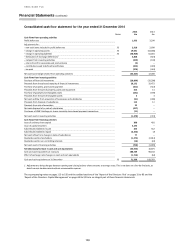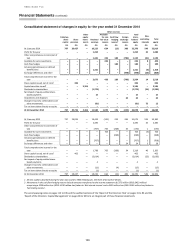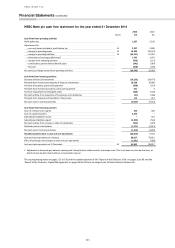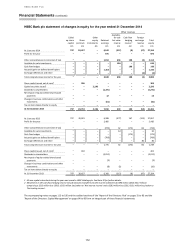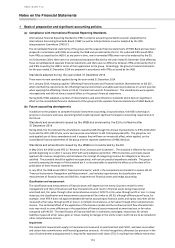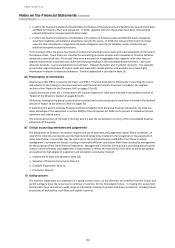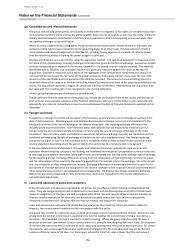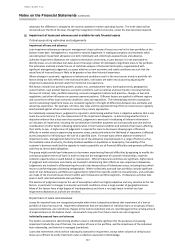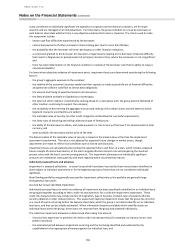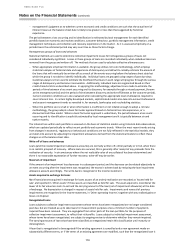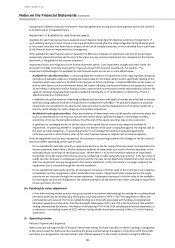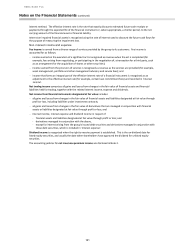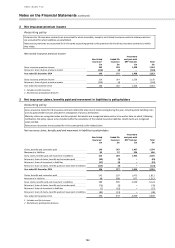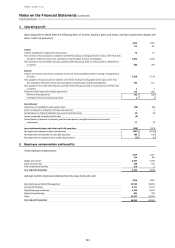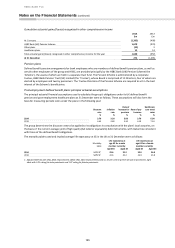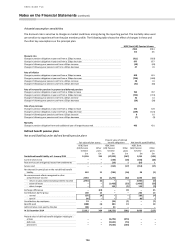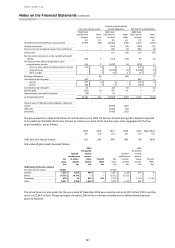HSBC 2014 Annual Report Download - page 119
Download and view the complete annual report
Please find page 119 of the 2014 HSBC annual report below. You can navigate through the pages in the report by either clicking on the pages listed below, or by using the keyword search tool below to find specific information within the annual report.
HSBC BANK PLC
Notes on the Financial Statements (continued)
117
advanced, the difference is charged to the income statement in other operating income. The write-down will be
recovered over the life of the loan, through the recognition of interest income, unless the loan becomes impaired.
(j) Impairment of loans and advances and available-for-sale financial assets
Critical accounting estimates and judgements
Impairment of loans and advances
Loan impairment allowances represent management’s best estimate of losses incurred in the loan portfolios at the
balance sheet date
. Management is required to exercise judgement in making assumptions and estimates when
calculating loan impairment allowances on both individually and collectively assessed loans and advances.
Collective impairment allowances are subject to estimation uncer
tainty, in part because it is not practicable to
identify losses on an
individual loan basis due to the large number of individually insignificant loans in the portfolio.
The estimation methods include the use of statistical analyses of historical informa
tion, supplemented with
significant management judgement, to assess whether current economic and credit conditions are such that the
actual level of incurred losses is likely to be greater or less than historical experience
.
Where changes in economic, re
gulatory or behavioural conditions result in the most recent trends in portfolio risk
factors being not fully reflected in the statistical models, risk factors are taken into account by adjusting the
impairment allowances derived solely from historical los
s experience.
Risk factors include loan portfolio growth, product mix, unemployment rates, bankruptcy trends, geographical
concentrations, loan product features, economic conditions such as national and local trends in housing markets,
the level of interes
t rates, portfolio seasoning, account management policies and practices, changes in laws and
regulations, and other influences on customer payment patterns
. Different factors are applied in different regions
and countries to reflect local economic conditi
ons, laws and regulations. The methodology and the assumptions
used in calculating impairment losses are reviewed regularly in the light of differences between loss estimates and
actual loss experience
. For example, roll rates, loss rates and the expected timing of future recoveries are regularly
benchmarked against actual outcomes to ensure they remain appropriate.
For individually assessed loans, judgement is required in determining whether there is objective evidence that a loss
event has occurred and,
if so, the measurement of the impairment allowance. In determining whether there is
objective evidence that a loss
event has occurred, judgement is exercised in evaluating all relevant information
on
indicators of impairment, including the consideration of whether payments are contractually past-due and the
consideration of other factors indicating deterioration in the
financial condition and outlook of borrowers affecting
their ability to pay
. A higher level of judgement is required for loans to borrowers showing signs of financial
difficulty in market sectors experiencing economic stress, particularly where the likelihood of repayment is affected
by the prospects for refinancing or the sale of a specified asset
. For those loans where objective evidence of
impairment exists, management determine the size of the allowance required based on a range of factors such as
the realisable value of security, the likely dividend available on liquidation or bankruptcy, the viability of the
customer’s business model
and the capacity to trade successfully out of financial difficulties and generate sufficient
cash flow to service debt obligations.
The group
might provide loan forbearance to borrowers experiencing financial difficulties by agreeing to modify the
contract
ual payment terms of loans in order to improve the management of customer relationships, maximise
collection opportunities or avoid default or
repossession. Where forbearance activities are significant, higher levels
of judgment and estimation uncertainty
are involved in determining their effects on loan impairment allowances.
Judgements are involved in differentiating the credit risk characteristics of
forbearance cases, including those which
return to performing status following renegotiation
. Where collectively assessed loan portfolios include significant
levels of loan forbearance, portfolios are segmented to reflect their specific credit risk characteristics, and estimates
are made of the incurred losses inherent within each forbearance portfolio seg
ments. Forbearance activities take
place in both retail and
wholesale loan portfolios.
The exercise of judgement requires the use of assumptions which are highly subjective and very sensitive to the risk
factors, in particular to changes in economic and c
redit conditions across a large number of geographical areas.
Many of the factors have a high degree of interdependency and there is no single factor to which our loan
impairment allowances as a whole are sensitive.
Impairment of loans and advances
Losses for impaired loans are recognised promptly when there is objective evidence that impairment of a loan or
portfolio of loans has occurred. Impairment allowances that are calculated on individual loans or on groups of loans
assessed collectively, are recorded as charges to the income statement and are recorded against the carrying amount
of impaired loans on the balance sheet. Losses which may arise from future events are not recognised.
Individually assessed loans and advances
The factors considered in determining whether a loan is individually significant for the purposes of assessing
impairment include the size of the loan, the number of loans in the portfolio, and the importance of the individual
loan relationship, and how this is managed (see below).
Loans that meet these criteria will be individually assessed for impairment, except when volumes of defaults and
losses are sufficient to justify treatment under a collective assessment methodology.



